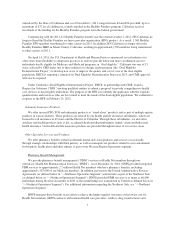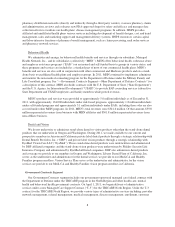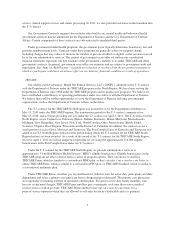Health Net 2011 Annual Report Download - page 19
Download and view the complete annual report
Please find page 19 of the 2011 Health Net annual report below. You can navigate through the pages in the report by either clicking on the pages listed below, or by using the keyword search tool below to find specific information within the annual report.(collectively, the “ACA”), which is causing and will continue to cause significant changes to the U.S. health care
system and alter the dynamics of the health care insurance industry. The provisions of the new legislation
include, among others, imposing significant new taxes and fees on health insurers that may not be deductible for
income tax purposes, including a health insurer fee on fully insured premiums and an excise tax on high premium
insurance policies, stipulating a minimum medical loss ratio (as adopted by the Secretary of the U.S. Department
of Health and Human Services (“HHS”)), limiting Medicare Advantage payment rates, increasing mandated
benefits, eliminating medical underwriting for medical insurance coverage decisions, or “guaranteed issue,”
increasing restrictions on rescinding coverage, or “rescissions,” prohibiting some annual and all lifetime limits on
amounts paid on behalf of or to our members, limiting the ability of health plans to vary premiums based on
assessments of underlying risk, limiting the amount of compensation paid to health insurance executives that is
tax deductible, expanding regulations that govern premium rate increase requests, in addition to requirements that
individuals obtain coverage and the creation of government controlled “exchanges” where individuals and small
business groups may purchase health coverage.
Some provisions of the health care reform legislation became effective in 2010, including those that increase
the restrictions on rescissions, those that bar health insurance companies from placing lifetime limits on
“essential benefits,” which are only partially defined, those that prohibit annual limits below specified caps for
essential benefits for some benefit plans and those that require health plans to cover certain out-of-network
services with no additional co-pay to their enrollees. Some provisions that significantly increase federal
regulation of the handling of appeals and grievances were to become effective in 2010, but enforcement of
certain of the provisions was postponed until July 1, 2011 and a subset of those again until January 1, 2012.
Additional provisions were effective in 2011, including medical loss ratio definitions and reporting requirements.
Others, such as the Summary of Benefits and Coverage (“SBC”) provisions outlined in a Final Rule published in
the Federal Register on February 14, 2012, are effective in 2012. Some of the potentially more significant
changes, including the annual fees on health insurance companies, the excise tax on high premium insurance
policies, the guaranteed issue requirements, the requirement that individuals obtain coverage, and the creation of
exchanges, as described above, do not become effective until 2014 or later. Implementation of other provisions
generally varies from as early as enactment or six months from the date of enactment to as late as 2018. In
advance of the September 2010 federal implementation date, we voluntarily provided the option of continuing
coverage for adult dependents up to age 26 who are currently enrolled on their parents’ health care policies. In
addition, we reaffirmed our existing policy against rescinding members without approval from an external third-
party reviewer, which has been in effect since 2007.
Various aspects of the health care reform legislation could have an adverse impact on our revenues,
enrollment and premium growth in certain products and market segments and the cost of operating our business.
Among other things, the legislation will require premium rate review in certain market segments, and require
premium rebates in the event minimum medical loss ratios are not met. We do not believe that we will be
required to pay a material amount in rebates with respect to our 2011 business, however, we cannot be certain
that we will not be required to pay material amounts in rebates in the future. In addition, the legislation will lower
the rates of Medicare payments we receive, may make it more difficult for us to attract and retain members, and
will increase the amount of certain taxes and fees we pay, which is expected to increase our effective tax rate in
future periods. However, we are unable to estimate the amount of these fees and taxes or the increase in our
effective tax rate because material information and guidance regarding the calculations of these fees and taxes
has not been issued. The new legislation will also impose a sales tax on medical device manufacturers and
increase the amount of fees pharmaceutical manufacturers pay (both of which in turn could increase our medical
costs). We could also face additional competition as competitors seize on opportunities to expand their business
as a result of the new legislation, though there remains considerable uncertainty about the impact of these
changes on the health insurance market as a whole and what actions our competitors could take. The response of
other companies to the ACA and related adjustments to their offerings, if any, could cause meaningful disruption
in the local health care markets. For example, companies could modify their product features or benefits, change
their pricing relative to others in the market, adjust their mix of business or even exit segments of the market.
Companies could also seek to adjust their operating costs to support reduced premiums by making changes to
17
























